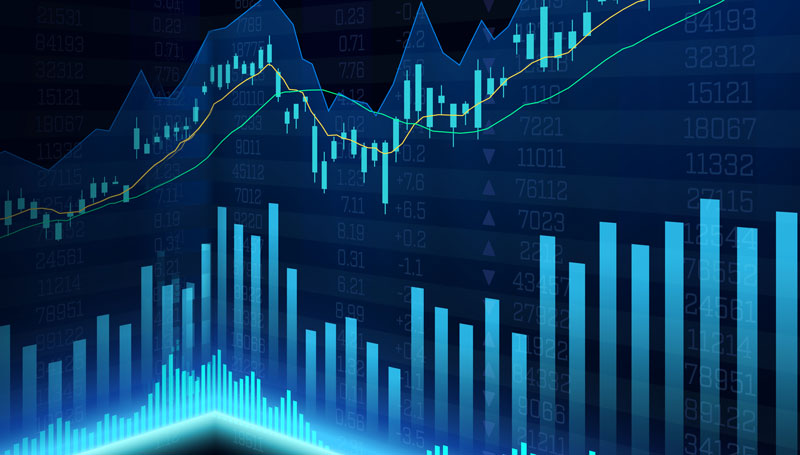

10.10.2019 – Daily Report. Hopes of a loosening of US monetary policy are pulling prices higher. But the smoldering customs dispute between Beijing and Washington is slowing the buying mood. The DAX remains moderately positive. The only thing that is clear is that volatility is unlikely to decrease in the near future.
Slight gains in Frankfurt
A test of patience for all those who trade stocks online: It’s not going well. By midday, the DAX was up 0.2 percent at 12,118 points. Yesterday, the German stock market indicator gained a good 1 percent. The day before, the leading German index had fallen below 12,000 points. Good times for all traders trading CFDs: The indecision in the market could make VIX and VDAX exposures interesting.
Will the Fed loosen further?
Many brokers wanted to see a small bullish signal in the Federal Reserve’s latest speech. According to the minutes of the 17th and 18th September interest rate meeting published yesterday evening, some members of the Federal Reserve recently saw growing threats to future economic development in the US. According to members of the Monetary Policy Committee, the risks to the economic outlook have risen somewhat since the July meeting. The main reasons were trade conflicts and the weakening global economy. At the September meeting, the Fed lowered the key interest rate by 0.25 percentage points to a range of 1.75 to 2.00 percent. This was the second rate cut in a row.
Long: Both sides agree
In the case of the customs dispute, investors had to deal with contradictory reports – negotiations in Washington continue today. Yesterday the Financial Times reported that China was offering to buy more American agricultural products. In the future it is expected to be 30 million tons of soybeans per year from the USA – ten million more than before. Bloomberg had also reported that the USA could postpone the tariff increase planned for next week. In return, Washington expects a currency pact. This brought the yuan into the focus of traders. The New York Times had also reported that the Trump administration wants to grant licenses again to some US companies that supply Huawei. This would mean a relaxation of the sanctions against the company. And the US stock exchange should be pleased.
Short: Disappointed hope
However, the official “South China Morning Post” has just reported that the negotiations under the leadership of China’s Deputy Prime Minister Liu He should now only last one day and not least two days until Friday as planned. The reason for the standstill is Beijing’s refusal to discuss the issue of illicit technology transfer. After that, the White House provided reassurance: CNBC reported that there was no information about a change in He’s plans. Later, however, the television station followed up and reported, citing an unnamed source, that everything was in flux: “Maybe Liu He would leave earlier than planned.
Asia and New York in positive territory
Before this back and forth, the Nikkei closed 0.4 percent higher at 21,552 points on Thursday. The Chinese CSI-300 even rose by 0.8 percent to 3,875 points. The evening before, Wall Street had recorded gains. The Dow Jones gained 0.7 percent to 26,346 points. The S&P 500 climbed 0.9 percent to 2,919 points. And on the Nasdaq, the composite gained around 1 percent to 7,903 points.
Turkish stock exchange and lira in crosshairs
Politics also moves courses elsewhere. After Turkey’s invasion of northern Syria, investors should keep an eye on Turkey’s leading index ISE 100 and the Turkish lira. Sanctions by the USA are now possible. Turkey wants to establish a “security zone” on its southern border and settle up to two million Syrian refugees there.
This is what the day brings
The dominant topic remains the customs dispute between China and the USA – be sure to keep your trading platform open and keep an eye on real-time prices. If it turns out that both sides have nothing to say to each other, Wall Street is likely to disappear. Because if there is no progress, Washington is likely to raise tariffs on Chinese imports totaling $250 billion from 25 percent to 30 percent starting next Tuesday. But if an agreement is reached, prices will rise.
Otherwise, the minutes of the meeting of the European Central Bank will be published at 1:30pm, which will bring EURUSD into focus.
At 2:30pm US consumer prices are reported for September, along with real incomes.
It will be exciting for equities, bonds and foreign exchange at 2:30pm when the weekly US initial claims for unemployment benefits come in.
OPEC is also publishing its monthly report.
As always, the calendar can be found here:Market Mover
The Bernstein Bank wishes you successful trades!
Important Notes on This Publication:
The content of this publication is for general information purposes only. In this context, it is neither an individual investment recommendation or advice nor an offer to purchase or sell securities or other financial products. The content in question and all the information contained therein do not in any way replace individual investor- or investment-oriented advice. No reliable forecast or indication for the future is possible with respect to any presentation or information on the present or past performance of the relevant underlying assets. All information and data presented in this publication are based on reliable sources. However, Bernstein Bank does not guarantee that the information and data contained in this publication is up-to-date, correct and complete. Securities traded on the financial markets are subject to price fluctuations. A contract for difference (CFD) is also a financial instrument with leverage effect. Against this backdrop, CFD trading involves a high risk up to the point of total loss and may not be suitable for all investors. Therefore, make sure that you have fully understood all the correlating risks. If necessary, ask for independent advice.
